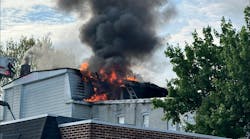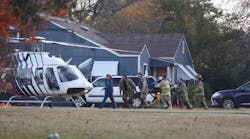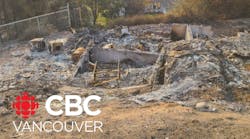No firefighter has been injured as a result of radio problems, but union representatives for firefighters say the risks are too great.
A blocked radio signal, which makes a "bonking" sound, "is the sound of death," said David Kearney, a Philadelphia paramedic and officer for Local 22 of the International Association of Fire Fighters.
Interference from cell phones on the 800-megahertz (MHz) band of the radio-frequency spectrum is a problem confronting firefighters, police, and emergency medical workers across the country.
Fire and police units in Philadelphia suburbs such as Upper Merion and East Norriton have complained of cell-phone interference. In New Jersey, state police have received reports of interruptions in every part of the state.
Last month, the Federal Communications Commission proposed moving all cell-phone carriers to one end of the 800-MHz band and all public-safety users to the other.
But any agreement would need the approval of Nextel Communications Inc. of Reston, Va., the largest commercial user of frequencies in the 800-MHz range. The plan calls for Nextel to acquire a new band of spectrum worth $4.8 billion. In return, the company would have to pay to reconfigure public-safety signals in the 800-MHz range.
Nextel is reviewing the FCC proposal, said Leigh Horner, a company spokeswoman.
Any plan, however, would take up to three years to put in place. In the meantime, Philadelphia firefighters have filed a steady number of complaints about interference.
At a house fire in Grays Ferry on June 27, for example, a fire chief who could not get through to crews via radio had to resort to yelling commands to firefighters inside, eyewitnesses said.
Lloyd Ayers, the city's acting fire commissioner, said his department was aware of the interference problems and was working with cell-phone carriers to find solutions.
"It's a big concern," Ayers said. "We're doing what we can to assure we have a remedy for this."
The Fire Department's Motorola 800-MHz radio system was installed in October 2002, replacing an outdated 150-MHz network. Both the Fire and Police Departments are hooked up to the Motorola system, which cost the city $54 million.
Cell-phone interference was not a problem with the old system because there were no cell-phone carriers operating on the 150-MHz band. But with the 800-MHz band, cell-phone signals are bumping up against public-safety channels.
City and fire officials say Nextel and Cingular Wireless are the suspected culprits. The city has hired technical experts to verify signal interference and to pinpoint which cell-phone carrier could be to blame.
Spokeswomen for Cingular and Nextel said their companies were cooperating with city officials.
Part of the problem is that city officials do not know where cell-phone towers are located, and companies hold that information close to the vest.
As a result, a firefighter making a call at an 850-MHz frequency might unknowingly be standing under a cell-phone antenna transmitting at 851 MHz. One signal could block the other.
Temporary fixes - such as adjusting frequencies or realigning towers - are neither reliable nor permanent, said Robert Gurss, director of legal affairs for the Association of Public-Safety Communications Officials.
"Even if you know how to fix it, you can't go through that process every time you have an interference problem," Gurss said. "It's a dangerous approach. You're chasing problems after they occur, and one of these days someone's going to die as a result."
Kearney, of the firefighters' union, said cell-phone interference is just one of many problems that first responders have found with the city's new radio system.
Kearney, who is tracking radio complaints for Local 22, said members had reported losing signals inside high-rises, warehouses, tunnels, elevators and basements. Communication into deep or dense sites such as Center City towers was a problem with the old radio system, and Kearney said the new radios have not alleviated the situation.
At a three-alarm high-rise fire on June 28, 2003, at 1919 Chestnut St., Kearney said, commanders in the lobby lost touch with firefighters on upper floors. Kearney, who was on duty that night, said a runner had to be sent to the 29th floor to tell firefighters to switch to the department's old radio system, which was still effective inside the high-rise.
Fire officials said they suspected cell-phone interference may have played a role in lost communication that day.
John McFadden, the sales vice president for Motorola who handles the Philadelphia contract, said the emergency radio system covers 95 percent of the city.
He said such factors as the number of high-rise buildings in an area or the amount of metal in a structure can block a radio signal.
"There's no such thing as 100 percent radio coverage," McFadden said. "There are always going to be dead spots."
Philadelphia police have not reported the same interference trouble as fire units. One reason could be that police units can move around more readily to get out from a blocked signal, according to Charles Brennan, deputy police commissioner in charge of technology.
The Police Department, however, has had problems of its own. On three occasions - March 25, May 18 and Aug. 18 - the radio system was either shut down for a few seconds or failed to activate all channels, Brennan said.
Philip R. Goldsmith, Philadelphia's managing director, said the new radio system is better than the old, mismatched systems for police and fire. He said that, for the first time, fire and police units can talk directly on the same channels. Also, the new system provides more-thorough coverage of the city.
But Goldsmith said the city is holding Motorola responsible for determining why the system has been hampered by occasional glitches.
"We still know there's an issue and still know that Motorola cannot say with certainty, 'We found what is causing this, case closed.' "
Related:
Related 'Technology & Communications' Articles by Contributor Charles Werner:




